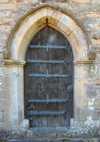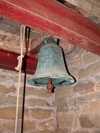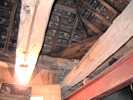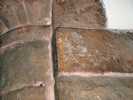For this church:    |
Halam St MichaelArchaeology
Significant Interior Features
Timbers and roofs
BellframeTwo steel RSJs, Taylors of Loughborough, 1965 Earlier wooden, Elphick B, Pickford Group 1.D (resting on timbers bearers), bell support timbers remain alongside. Probably late medieval or medieval re-used. Present frame not scheduled for preservation Grade 5. Earlier frame scheduled for preservation Grade 1.
Walls

Excavations and potential for survival of below-ground archaeologyNo recorded archaeological excavations have taken place in the interior of the church. The whole interior was heavily disturbed between 1862 and 1885 when sucessive restorations took place in the chancel and nave. The south aisle was rebuilt in c.1885 and disturbance must have been considerable. However, the core of the building has no evidence of vaults and may have relatively intact medieval stratigraphy below the C19th disturbance.
The upstanding fabric is, in parts, complex: in particular the north wall of the chancel and the whole of the tower appear to be unaffected by later restorations and the archaeology in these areas is considered to be of great significance to the building. The south churchyard contains a good selection of grave markers from the C18th onwards and appears to be little disturbed away from the rebuilt south aisle. It is likely that archaeology survives from the medieval church and later in this area. In 2002 an archaeological watching brief was carried out on the excavation of drains and sumps in the churchyard to the north and south sides of the nave and south aisle. Relatively large amounts of disarticulated human bone were recorded and two grave-cuts were noted within the drainage footprint. The subsoil contained modern brick and glass togther with some stone fragments, and it would appear that these areas, adjacent to the church building, have been heavily disturbed during and since the C19th. The overall potential for the survival of below-ground archaeology in the churchyard is considered moderate and below the present interior floors is considered to be high. Exterior:Burials expected generally, multiperiod. Areas immediately surrounding building are likely to have been heavily disturbed in the late C19th and more recently in 2002. Excavations indicate that considerable amounts of disarticulated human bone will be encountered. Interior: Extent of C19th disturbance is conjectural, although all floors have been re-set and restored. The floors are likely to be punctuated by late medieval graves and medieval stratigraphy may survive relatively intact below this disturbance. Walls: Complex mixture of C12th-C16th, and C19th rebuilding and alteration. Tower and north chancel are important. |


 Earliest core fabric
is C12th - nave/chancel junction fabric and N.chancel lower walls
Earliest core fabric
is C12th - nave/chancel junction fabric and N.chancel lower walls







